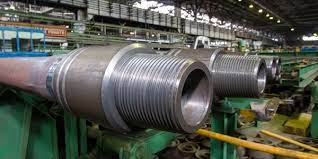Drill Pipe Manufacturing Process: From Raw Materials to Final Product

Drill pipes are essential in drilling operations, transmitting drilling fluid to the drill bit and providing structural support to the entire drilling assembly. Their significance lies in facilitating efficient and effective drilling processes across various industries, including oil and gas exploration, geothermal drilling, and mineral extraction. Understanding the drill pipe manufacturing process is crucial to appreciate the complexities involved in producing these vital tools.
Manufacturing drill pipes involves intricate steps to ensure durability, reliability, and performance in demanding drilling environments. This article overviews the manufacturing process, highlighting the critical stages from raw materials to the final product. By examining each phase in detail, readers can gain insights into the craftsmanship and precision required to manufacture drill pipes that meet the industry’s rigorous standards.
Contents
Raw Materials
- Drill pipes are primarily made from steel alloys.
- Steel alloys are unique mixtures of iron and other elements like carbon and chromium.
- These alloys are chosen for their strength, durability, and resistance to corrosion.
- Quality is crucial because it ensures the drill pipe can withstand the harsh drilling conditions.
- Specifications, such as the composition of the steel and its mechanical properties, must meet industry standards.
- High-quality raw materials contribute to the overall performance and longevity of the drill pipe.
- Manufacturers carefully select and test materials to ensure they meet the required standards.
- Drill pipe manufacturers can use top-quality materials to produce reliable products that perform effectively in various drilling environments.
- The right materials help reduce the risk of pipe failure and ensure safer drilling operations.
Pipe Body Fabrication
Forming the Pipe Body from Raw Materials
In this stage, the raw materials, typically strong steel alloys, are shaped into the main body of the drill pipe. The process involves heating the steel to a high temperature and molding it into the desired shape. This can be done through methods like forging, where the steel is hammered into shape, or extrusion, where it’s forced through a die to form a cylindrical shape. The goal is to create a sturdy and uniform pipe body that can withstand the rigors of drilling operations.
Methods Such as Seamless or Welded Construction
After shaping the pipe body, it can be further refined using different construction methods. Seamless construction involves forming the pipe body without seams or joints, resulting in a continuous and robust structure. On the other hand, welded construction involves joining separate pieces of steel together using welding techniques. Both methods have advantages and are chosen based on cost, durability, and specific drilling requirements.
Heat Treatment
Heat treatment plays a vital role in strengthening drill pipes, ensuring they can withstand the demanding conditions of drilling operations. The steel’s microstructure is altered by subjecting the pipe to controlled heating and cooling processes, enhancing its mechanical properties such as hardness and toughness.
During heat treatment, the drill pipes are typically heated to temperatures ranging from around 850 to 1100 degrees Celsius (1562 to 2012 degrees Fahrenheit), SOSSUSA depending on the steel alloy used and desired properties. The duration of heating varies but typically lasts for several hours to ensure uniformity and thorough transformation of the material’s structure.
By carefully controlling the temperature and duration of the heat treatment process, manufacturers can tailor the properties of the drill pipes to meet the requirements of various drilling applications, ultimately enhancing their durability and performance in the field.
Tool Joint Manufacturing
What are Tool Joints?
Tool joints are specialized components of drill pipes that connect the pipe sections and the drill bit. They are crucial in transmitting rotational torque and axial loads during drilling operations. Tool joints are designed to withstand harsh drilling conditions, including high pressures and abrasive environments.
Manufacturing Processes
The manufacturing of tool joints involves several steps. First, raw materials, usually high-quality steel alloys, are selected based on specific requirements. Then, the materials undergo precision machining processes such as turning, threading, and heat treatment to achieve the desired shape, strength, and durability. Quality control measures are implemented throughout the manufacturing process to ensure that tool joints meet strict industry standards for performance and safety. Once manufactured, the tool joints are carefully inspected and tested before being assembled onto the drill pipe sections, ready for use in drilling operations.
Welding
Joining the Pipe Body and Tool Joints
Workers join the pipe body in the welding stage with the tool joints. This step is crucial because it forms a strong connection to withstand the pressures and stresses encountered during drilling operations. Welding is like melting the edges of the pipe and the tool joints together to create a solid bond.
Techniques Used in Welding and Ensuring Integrity
Various techniques are employed to weld the pipe body and tool joints securely. Skilled welders use arc welding or gas tungsten arc welding (GTAW) to ensure a reliable and durable weld. To guarantee the integrity of the weld, rigorous inspection processes are implemented. This involves checking for any defects or weaknesses that could compromise the strength of the weld. Ensuring the integrity of the weld is essential for maintaining safety and efficiency in drilling operations.





